Hawaii is home to a rich diversity of dolphin species, from the acrobatic Spinner Dolphin to the large and mysterious False Killer Whale. These marine mammals thrive in the islands’ warm, clear waters, offering unforgettable wildlife encounters.
Visitors can often see dolphins in shallow bays, along coastlines, and offshore, with each species displaying unique behaviors, social structures, and feeding habits. Snorkelers, boaters, and wildlife enthusiasts all have opportunities to witness these fascinating creatures in their natural environment.
Understanding the best times and places to spot dolphins, as well as their habits and interactions, can enhance every Hawaiian wildlife experience. Respectful observation ensures the protection and enjoyment of these intelligent and playful animals.
Most Common Types of Dolphins Found in Hawaii
Spinner Dolphin (Stenella longirostris)
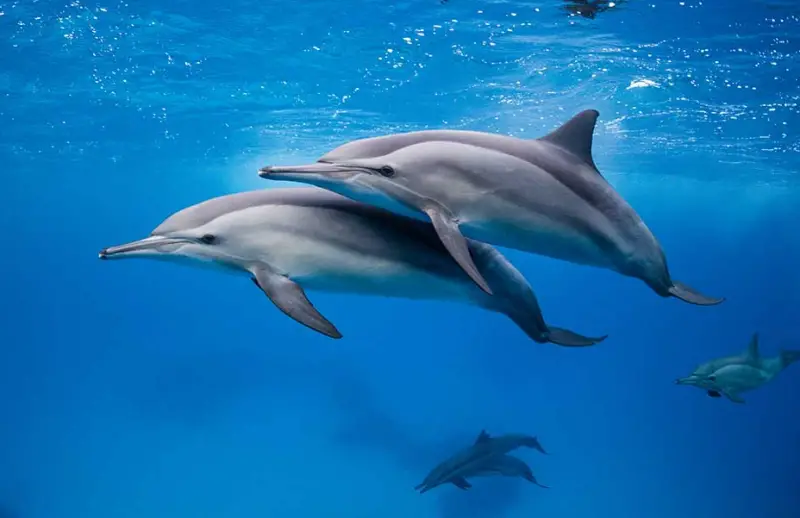
The Spinner Dolphin is arguably the most iconic dolphin species in Hawaii, renowned for its acrobatic spinning leaps that can rotate multiple times in midair. These small, agile dolphins typically range from 5 to 7 feet in length and weigh up to 170 pounds. Their slender, streamlined bodies are gray on the back with lighter underbellies, and their long, thin beaks make them easily distinguishable from other local dolphin species. Large pods, sometimes numbering in the hundreds, can often be seen circling near the islands, creating a spectacular display for wildlife watchers.
Spinner Dolphins are highly social creatures that live in tightly-knit pods. During the day, they often rest in shallow, protected bays such as Kealakekua Bay on the Big Island or Hanauma Bay on Oahu, where the calm waters provide safety from predators. At night, these dolphins travel offshore in search of food, feeding primarily on small fish and squid in deeper waters. Their remarkable spinning behavior is not only entertaining but may serve purposes such as communication, social bonding, or dislodging external parasites.
These dolphins have developed a unique daily rhythm, balancing periods of rest and activity across the Hawaiian coastline and surrounding ocean. Observing their behavior provides insights into their intelligence and social structure. Spinner Dolphins often synchronize their movements within pods, surfacing and diving in harmony, which makes group displays particularly mesmerizing. Researchers continue to study these dolphins to understand their social dynamics, migration patterns, and interactions with other marine species.
Spinner Dolphins are fully protected under the Marine Mammal Protection Act, making it illegal to harass or approach them too closely. Responsible boating and wildlife tourism practices are crucial to their well-being, as human disturbance can disrupt their resting and feeding routines. Snorkelers and tour operators are encouraged to maintain a respectful distance and avoid entering their resting bays, ensuring that both locals and visitors can enjoy encounters with these acrobatic dolphins safely and sustainably.
Bottlenose Dolphin (Tursiops truncatus)
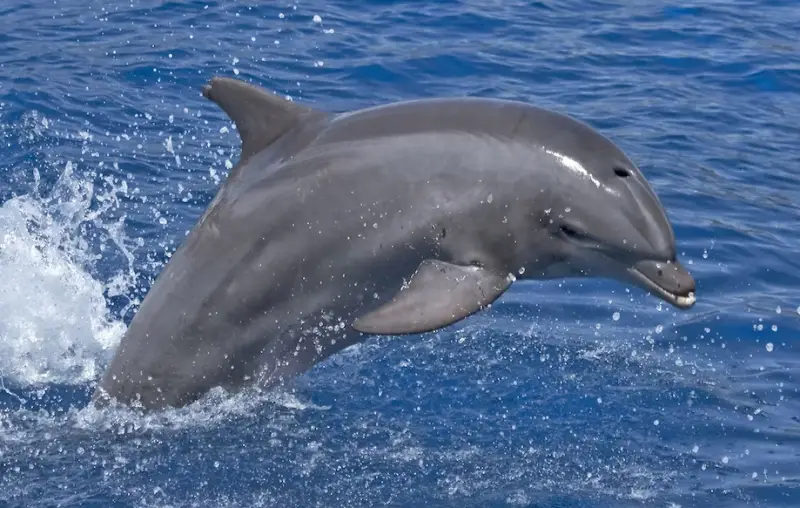
The Bottlenose Dolphin is one of the most recognizable and widely studied dolphin species in the world, and it is commonly found in Hawaiian waters. Larger than the Spinner Dolphin, these dolphins typically grow between 8 and 12 feet in length and can weigh up to 1,200 pounds. Their robust, stocky bodies, short rounded beaks, and curved dorsal fins make them easy to identify, and their gray coloration—darker on the back and lighter on the belly—helps them blend into the ocean environment.
Bottlenose Dolphins inhabit a variety of marine environments, from deeper offshore waters to areas closer to shorelines around the islands. They are highly intelligent and extremely social, often interacting with boats, surfers, and other marine wildlife. Their playful behavior is well-known, and they frequently ride the bow waves of vessels, leap from the water, and perform spins and twists, delighting observers.
These dolphins live in flexible social groups called pods, which can consist of just a few individuals or more than 20 members. They are opportunistic feeders, consuming a diet of fish, squid, and crustaceans, and they rely on echolocation to locate and capture prey. Their social intelligence is evident in coordinated hunting strategies, care of young, and communication using clicks, whistles, and body language.
Bottlenose Dolphins are spotted in Hawaiian waters year-round, making them a favorite for wildlife enthusiasts and dolphin-watching tours. Responsible interaction is essential, as excessive human disturbance can disrupt feeding, social behavior, and rest. Observers are advised to maintain a safe distance, allowing these intelligent and playful creatures to thrive naturally while still providing unforgettable experiences for visitors.
Pantropical Spotted Dolphin (Stenella attenuata)
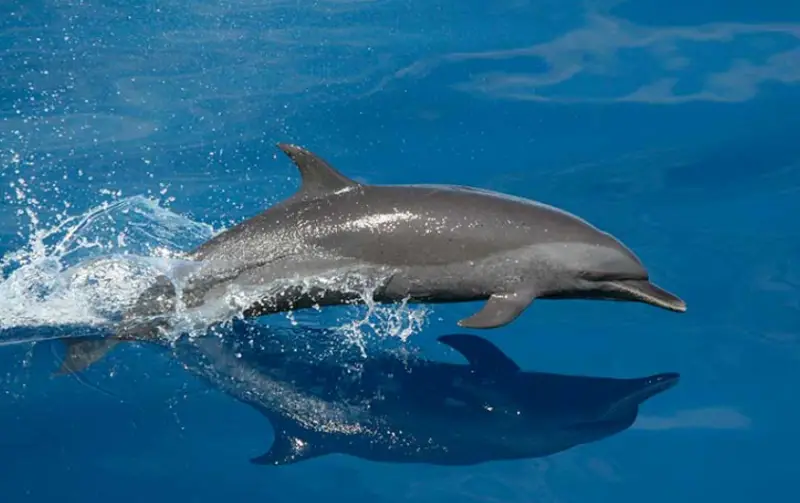
The Pantropical Spotted Dolphin is a smaller, slender dolphin species commonly found in the warm waters around Hawaii. Adults measure between 6 and 8 feet in length and weigh around 250 pounds. One of their most distinctive features is their spotted coloration, which develops with age—juveniles are nearly spotless, while adults display a pattern of dark spots on their sides, back, and belly. This gradual change in appearance makes identifying different age groups relatively easy for observers.
These dolphins are highly active and often travel in large, dynamic pods that can number from a few dozen to over a hundred individuals. Known for their speed and agility, Pantropical Spotted Dolphins frequently leap out of the water, perform acrobatic spins, and ride the bow waves created by boats. Their playful nature and energetic displays make them a favorite among dolphin watchers and snorkelers venturing into Hawaiian waters.
Unlike Spinner Dolphins, Pantropical Spotted Dolphins do not typically rest in sheltered bays. Instead, they spend most of their time in offshore, open ocean environments where they can freely forage and socialize. They are primarily nocturnal feeders, hunting fish and squid that rise closer to the surface at night, and they often use coordinated hunting strategies within the pod to capture prey efficiently.
These dolphins demonstrate a complex social structure, with strong interactions among pod members. Communication occurs through a series of clicks, whistles, and body movements, allowing them to coordinate movement, hunting, and play. While they are not as commonly seen close to shore as Spinner Dolphins, responsible boat tours and eco-friendly observation provide opportunities to witness their fascinating behavior without disturbing their natural patterns.
Rough-toothed Dolphin (Steno bredanensis)
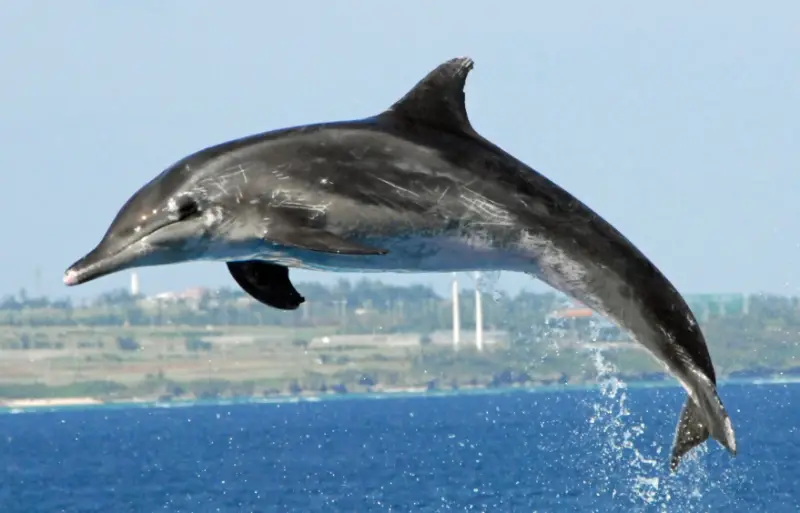
The Rough-toothed Dolphin is a medium-sized dolphin species that is less commonly observed than the Spinner or Bottlenose Dolphins in Hawaiian waters, but it is present year-round. It is easily identified by its long, slender beak, sloping forehead, and the unique ridges on its teeth, which give the species its name. The body is typically dark gray with lighter patches around the lips and belly, and these subtle markings help distinguish it from other dolphins in the region.
Adults generally measure 8–9 feet in length and weigh between 200 and 350 pounds. Their moderately sized, streamlined bodies make them well-adapted to life in deeper offshore waters, where they are most frequently encountered. Unlike some of the more coastal species, Rough-toothed Dolphins are rarely seen close to shore, preferring the open ocean and deeper channels around the Hawaiian Islands.
These dolphins are known for their shy and reserved nature, making them less acrobatic than Spinner or Pantropical Spotted Dolphins. Despite their quieter demeanor, they are highly social animals, often traveling in small pods of a few individuals. Occasionally, these pods will join with other dolphin species or even certain whale species, forming temporary mixed groups for foraging or social interaction.
Observations of Rough-toothed Dolphins are relatively rare, which makes encounters particularly exciting for researchers and wildlife enthusiasts. Their elusive behavior and offshore habitat mean that careful, respectful observation is crucial to avoid disturbing their natural patterns. Conservation measures and responsible wildlife viewing help ensure that this unique species continues to thrive in Hawaii’s rich marine ecosystem.
False Killer Whale (Pseudorca crassidens)
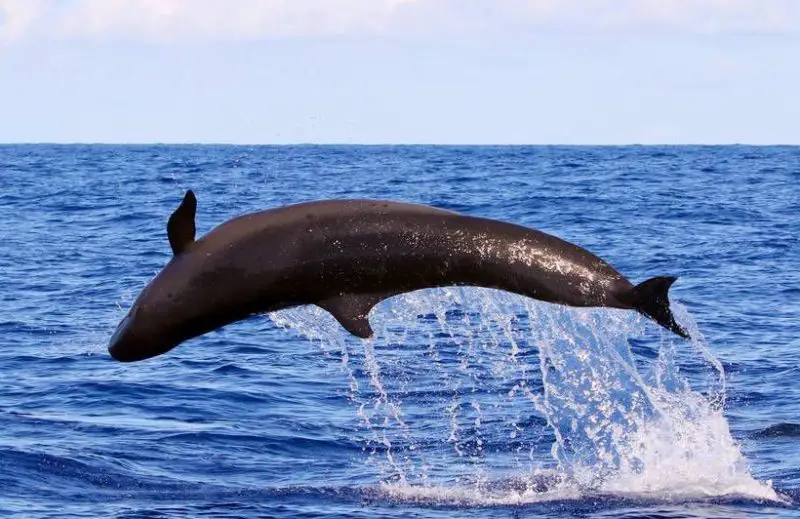
Despite its name, the False Killer Whale is actually a member of the oceanic dolphin family and is found in Hawaiian waters. This large, powerful dolphin can reach lengths of 15 to 20 feet and weigh up to 3,000 pounds. Its long, slender body, rounded head, and dark gray coloration make it distinctive among Hawaii’s marine mammals. Although it shares the “whale” name, its behavior and anatomy align closely with other dolphins, including social complexity and hunting strategies.
False Killer Whales are highly social and form strong, long-lasting bonds within their pods. Individuals often remain with the same pod for life, demonstrating remarkable loyalty and cooperation. These dolphins are apex predators within their environment, preying on large fish and squid, and they have even been observed hunting smaller dolphin species in some instances. In Hawaiian waters, a distinct resident population exists that is unique to the region.
This population is considered endangered due to low numbers, and it faces several threats, including entanglement in fishing gear and declining availability of prey. Conservation efforts in Hawaii focus on monitoring populations, regulating fisheries, and educating the public about responsible wildlife interactions. Protecting this species is crucial to maintaining the balance of the local marine ecosystem and ensuring their survival for future generations.
False Killer Whales are occasionally curious around humans, sometimes approaching boats or interacting with divers. There are rare reports of them offering fish to people, demonstrating their intelligence and social complexity. Observers are encouraged to maintain a respectful distance, allowing these majestic dolphins to engage in natural behaviors while promoting safe and sustainable wildlife encounters in Hawaiian waters.
Best Time and Places to See Dolphins in Hawaii
Hawaii offers some of the best opportunities in the world to observe dolphins in their natural habitat. While dolphins can be seen year-round, the best time for sightings is generally during the calm, clear months from May to October, when ocean conditions are ideal for boating, snorkeling, and wildlife tours. Early mornings are also recommended, as the seas are typically calmer and dolphin activity is higher before the midday heat and boat traffic increase.
Kealakekua Bay on the Big Island is one of the most famous locations, known for Spinner Dolphins resting in shallow waters during the day. Hanauma Bay on Oahu provides opportunities for snorkelers to observe Bottlenose and Spinner Dolphins near the reef. The Waianae Coast of Oahu is another popular spot, frequented by Bottlenose Dolphins and occasionally Pantropical Spotted Dolphins.
Offshore waters near Maui and Kauai are ideal for spotting Rough-toothed Dolphins, Pantropical Spotted Dolphins, and False Killer Whales in deeper waters. The channels between Lanai and Molokai are excellent for observing offshore species like False Killer Whales and Melon-headed Whales. Tours with certified guides or eco-friendly operators are highly recommended to ensure safe and respectful wildlife encounters while avoiding disturbances to resting or feeding pods.
FAQs About Dolphins in Hawaii
What types of dolphins are most commonly seen in Hawaii?
The four most commonly observed dolphin species are Spinner Dolphin, Bottlenose Dolphin, Pantropical Spotted Dolphin, and Rough-toothed Dolphin. Additionally, the False Killer Whale can occasionally be seen in offshore waters.
Can I swim with dolphins in Hawaii?
Yes, but only in a safe and legal manner. Entering bays where dolphins rest or approaching pods too closely is discouraged. Licensed wildlife tours offer guided swimming experiences while following strict regulations under the Marine Mammal Protection Act.
Are dolphins in Hawaii endangered?
Most common species like Spinner and Bottlenose Dolphins are not endangered. However, the False Killer Whale population in Hawaii is considered endangered due to low numbers and threats such as fishing gear entanglement.
When is the best time of day to see dolphins?
Early morning is generally the best time for sightings. Dolphins are more active in calm seas before heavy boat traffic and midday ocean activity, especially for offshore species.
Do dolphins interact with humans?
Some species, like Bottlenose Dolphins and False Killer Whales, occasionally approach boats or snorkelers out of curiosity. Maintaining a respectful distance is crucial to avoid stressing the animals or disrupting their natural behaviors.






